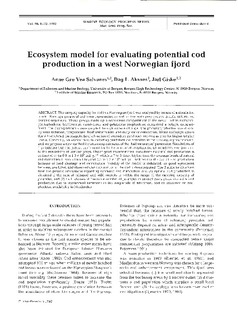| dc.description.abstract | The carrying capacity for cod in a Norwegian fjord was analysed by means of a simulation model. Four age groups of cod were represented as well as the main prey groups labrids, gobies and benthic organisms. These groups made up a near-shore compartment of the model, while nutrients, phytoplankton, herbivorous, carnivorous and gelatinous zooplankton comprised a pelagic compartment. The 2 compartments were coupled through water exchange. The primary production was driven by solar radiation, temperature, freshwater runoff, and deep water convection. Water exchange across the sill regulated the magnitude of advection of secondary producers serving as prey for higher trophic levels. Generally, simulation models including predation are sensitive to the feeding representations, and we propose a new method for obtaining estimates of the 'half-saturation' parameter. Simulations of 1 yr indicate that cod production is sensitive to the amount of zooplankton advected into the fjord and to the availability of benthic preys. Under good environmental conditions maximal cod production is estiMated to be 0.5 to 1.3 x 10(6) ind. yr-1, which is 7 to 8 times higher than the average levels of natural cod recruitment. Recruitment beyond 0.5 to 1.3 x 10(6) ind. yr-1 will reduce the overall cod production because of food shortage and cannibalism. Validity of the model is indicated, as good agreement between predicted and observed diet composition of the cod is demonstrated. The 2 main implications from the present simulations regarding extensive cod mariculture are: (1) optimal cod production is obtained if the sum of released and wild recruits is within the range of the carrying capacity of juveniles; and (2) that releases of the same number of juveniles in several years gives dissimilar cod production due to interannual variations in the magnitude of advection, and its influence on zooplankton availability in Masfjorden. | en |
